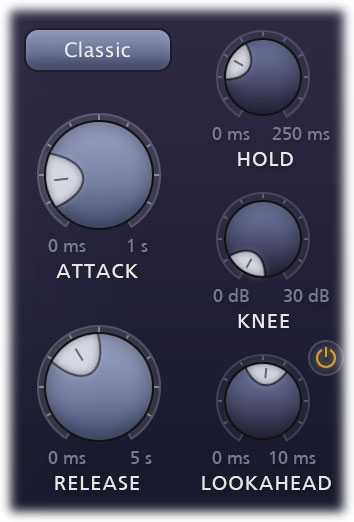FabFilter Pro-G online help
Table of contents
Go to sectionFabFilter Pro-G Help
Introduction
Using FabFilter Pro-G
Full Screen mode, resizing and scaling
Presets
Purchasing FabFilter Pro-G
Support
Time controls, style and knee
The section at the right of the interface contains the controls that affect the speed and feel of the current chosen gate/expander style.

Style
With the Style selection button, you can choose between various gate/expander styles, all tailored and fine-tuned carefully to meet specific needs or offer a certain character:
- Classic
This style brings you the flavor of gating and expansion as often found in vintage, high end mixer channel strips. It can be quite aggressive, but also subtle when needed. It's a great all-round style for mixing purposes and works especially well on drums. - Clean
Designed to be as clean as possible and minimize flutter and distortion, the Clean style is great for transparent gating and expanding. - Vocal
Since a gate/expander is very often used on vocals, we have developed a special vocal gating algorithm. It retains the natural feel of the vocal, opening the gate gently when the singer breathes in, and releasing gently, yet fast enough to reduce unwanted noise or bleed. - Guitar
Another common application of a gate/expander is on electric guitar before distortion, to reduce or miminize rumble. With this style, expecially when used in the lower ratio range (2:1 to 5:1), Pro-G gently follows the natural decay of the guitar sound, ensuring that even after distortion, the result still sounds very natural and lively. - Upward
As a special treat, an upward expansion algorithm is also included. When you choose this style, separate Threshold and Ratio parameters are used with custom, smaller ranges. In Upward mode, the expander will amplify signals above the threshold instead of reducing them below threshold. When used moderately and with care, you can achieve very natural and transparent sounding expansion effects. - Ducking
Finally, Pro-G also features a dedicated ducking mode, as found in many classic gates. A typical application of ducking is to automatically lower the level of a musical background track when a voice-over starts, and to automatically bring the level up again when the voice-over stops (in movies and on radio broadcasts). It is similar to compression with a side-chain, but it can sound quite different, because it's processed as 'inverted' gating instead of compression. Ducking can also be used to achieve the well-known and very popular 'pumping' effect, much used in modern dance music.
All styles have built-in, carefully tuned hysteresis where needed. This will cause the gate to close at a slightly lower threshold level than the threshold at which it will open (as set by the Threshold knob), avoiding flutter when the incoming audio signal hovers around the threshold.
Attack
The Attack knob sets the speed with which the expander/gate will open when the signal level exceeds the threshold. For transient-rich program material like drums, fast attack times are needed to preserve punch. FabFilter Pro-G is capable of very fast attack times and they are program dependent.
Release
The Release knob sets the time that the expander/gate takes to close and reach maximum gain reduction. Just like the attack, the behavior is very program dependent, depending heavily on the audio you're processing.
Hold
The Hold knob sets the minimum time that the gate/expander will remain fully opened after the sound level has exceeded the threshold.
Knee
By choosing a custom soft knee setting, the gate/expander will react more gradually when sound drops below the threshold. You can of course clearly see the effect of the Knee in the transfer curve shown within the level display.
Lookahead
With the Lookahead knob (often also called pre-open), the gate/expander can be set to open up to 10 ms before the audio level actually exceeds the threshold. This is an excellent way to preserve transients, while still avoiding ultra-fast attack times that might cause distortion or aliasing.
You can enable or disable look-ahead with the Lookahead Enabled button, just at the right-top of the Lookahead knob. When look-ahead is disabled and oversampling is off, Pro-G works without any latency. When enabled, the latency will be 10 ms, plus a small additional latency if oversampling is enabled.
Tips
- When using Upward expansion, it's best to avoid using high ratios in combination with a low threshold, because this can lead to quite extreme amplification.
Next: Metering
See Also
Dynamic controls
Oversampling
